In Defense of Trans Attraction

Introduction
My whole life, I have never had concern for what people think of me. Perhaps that is a privilege. Whatever I liked or disliked, was simply a reflection of who I am, not a measure of my worth or “moral standing.” But over time, I have come to understand that most people live in constant fear of judgment, especially in matters of attraction and identity. This is particularly true for straight men attracted to trans women (which for our purposes will simply be called trans attraction).
The purpose of this article is to:
- Provide a grounded perspective on why it is reasonable for straight men to find trans women
attractive.
- Dispel the “gay” label often used to attack men who feel this attraction.
- Expose the motivations behind those who seek to shame and disparage straight men attracted to trans women.
- Alleviate any concerns or anxieties that straight men (who may not be open about their attraction) or cis women dating these men might have.
By the end of this article, I am confident that it will be abundantly clear how reasonable and natural it is for straight men to find trans women attractive.
Impetus
Much of what prompted me to write about this topic (besides my own attraction to trans women), and take up the proverbial flag in this battle, was seeing how many people HATE that straight men find transwomen attractive. Case in point the tweet below:
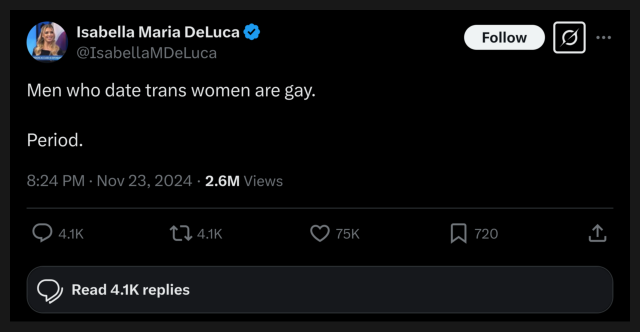
For now, I am only introducing the argument that these detractors use to attack trans-attracted men. They assert that men attracted to trans women are “gay”, because a trans woman is a biological male (albeit significantly feminine). Therefore any male who finds them attractive must also be “gay.” That is the gist of their argument, and we will soon see why not only is this unequivocally false, it is quite bad faith in nature.
Clarifying Terminology
Before diving into the core argument, it is important to clarify the meaning of certain terms, as they will be used throughout this article. A major point of confusion in discussions about trans attraction comes from the way we define sexual orientation: the difference between biological sex-based and gender-based attraction.
Homosexual vs. Heterosexual
The terms homosexual and heterosexual are often understood in a strict biological sense:
- Homosexual (from Greek homo- meaning “same”) means attraction to the same sex.
- Heterosexual (from Greek hetero- meaning “different”) means attraction to the opposite sex.
However, these terms tell us very little about what actually drives attraction. They are purely technical descriptions based on biological sex, but they fail to account for one of the most important aspects of human sexuality: the role of masculine and feminine traits in shaping desire.
Gay vs. Straight
In common usage, gay and straight are often understood more in terms of gender expression:
- A gay man is generally thought of as a man attracted to masculinity, rather than strictly to male bodies.
- A straight man is a man attracted to femininity, rather than strictly to female bodies.
This distinction is crucial because it highlights a gap in terminology. If “straight” means “attracted to femininity,” then a man who is attracted to a feminine trans woman is still straight. But if “heterosexual” means “attracted exclusively to female bodies,” then some might argue that trans-attracted men fall outside of that definition.
This exposes a larger issue: homosexual and heterosexual as rigid sex-based categories do not actually explain much about the nature of attraction itself. They do not distinguish between attraction to masculinity or femininity, which is often the more relevant factor in real-world desire. A person who is “homosexual” in the strictest sense could theoretically be someone attracted to a highly feminine gay man or a hyper-masculine one, but those are radically different types of attraction. The same applies to heterosexuality.
In other words, the terms homosexual and heterosexual are not particularly useful in capturing the nuances of human attraction. They are clinical labels that reduce sexuality to anatomy while ignoring the psychological and social dimensions that actually drive desire. In contrast, gay and straight — understood as attraction to masculinity and femininity, respectively — offer a clearer and more functional framework for understanding human sexuality.
For the sake of clarity, this article will use straight to mean attracted to femininity and gay to mean attracted to masculinity, rather than rigidly tying these terms to biological sex. This better reflects how attraction actually functions for most people and avoids the misleading implications that arise from conflating different definitions.
What Do We Mean by “Trans Woman” and “Trans Man”?
The final point of clarification is how we define trans woman and trans man in this discussion. These terms can encompass a wide range of gender expressions, but for the sake of this article, we are referring specifically to:
- Trans women (in this article) refers to highly feminine-presenting trans women, such as
Blaire White, who align with traditional femininity in appearance and
behavior.
- Trans men (in this article) refers to highly masculine-presenting trans men, such as Buck Angel, who embody traditional masculinity.
This is important because attraction is largely driven by gender expression. A straight man attracted to a highly feminine trans woman is responding to her femininity, just as a gay man attracted to a hyper-masculine trans man is responding to his masculinity. Without this distinction, the conversation becomes muddled, as trans identity alone does not dictate presentation or attraction.
A Tale of Two Options
We will begin to present our case (which is very simple) for why trans attraction (in this case straight men attracted to trans women) is simply straight. We first begin with figure 1 below:
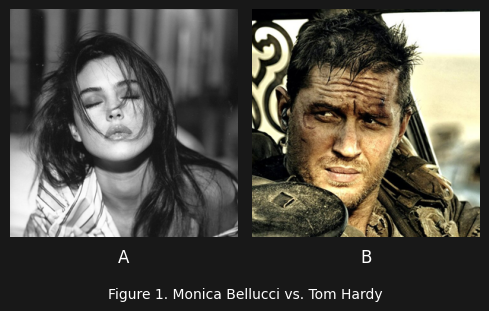
Of these two options A and B in figure 1 above, which do you think a straight male would find attractive? If you said A you would be correct. Also, we would expect a gay male to find B attractive. As we have pointed out previously, this concept of straight vs. gay is truly easy enough to grasp:
- straight males: find feminine features attractive (i.e. women like option
A(Monica Belucci)) - gay males: find masculine features attractive (i.e. men like option
B(Tom Hardy))
Let us look at another comparison in figure 2:
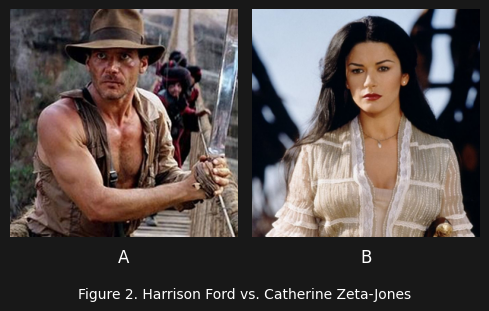
Again, considering the previous comparison in figure 1 it is not surprising that straight males find option B (Catherine Zeta-Jones) attractive in figure 2. It is the same simple logic: straight males find feminine features attractive. Let us try one more:
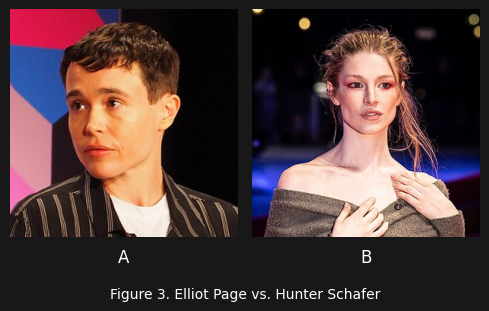
So obviously in figure 3 we would expect that straight males would find B attractive, but there is a twist (if you do not already know): option B (Hunter Schafer) is a biological male (i.e. she has XY chromosomes). Whereas option A (Elliot Page) is a biological female with XX chromosomes.
This is where things get interesting: is it “gay” for biological males to find Schafer attractive or Page?
Based on our conclusions from figures 1 & 2 above, we would expect gay males to find option A more attractive (because A has the most masculine features of the two options), and of course straight males to find option B more attractive (because B possesses the most feminine features). Let us look at one final figure that explores this dilemma:
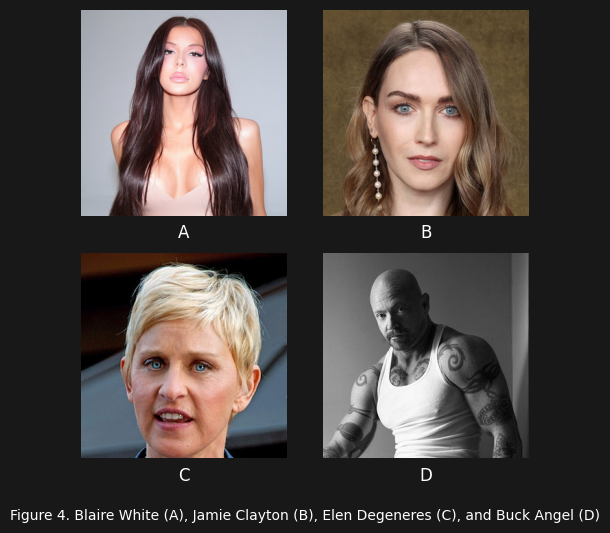
Both options C (Elen DeGeneres) and D (Buck Angel) in figure 4 above are biological females (i.e. they have XX chromosomes). We would expect that 0.00% of straight males find option D attractive, along with the vast majority having no attraction to option C. But we would absolutely expect those same straight males find options A (Blaire White), and B (Jamie Clayton) attractive (which are trans women). And again why would we expect this? Because options A and B are extremely feminine (especially compared to options C and D).
What I am suggesting is a simple truth that explains a lot about the attraction of straight males to trans women: straight males are attracted to femininity. Even when given the option of a biological female who is masculine (options C and D) vs. a biological male who is feminine (options A and B), straight males would be attracted to the later (and gay males would be attracted to the former). This is the simple logic that governs the gay / straight divide.
Reductio ad Absurdum
Now we return to the argument presented by those who seek to label trans-attracted men as gay, and we see how completely unfounded and inaccurate it truly is. If it is “gay” for men to find trans women like Blaire White, Jamie Clayton, and Hunter Schafer attractive, then it must be “straight” to find a trans man (like option D (Buck Angel) in figure 3 above) attractive. But that does not make any sense. No straight male would find Buck Angel attractive any more than they would find Tom Hardy or Harrison Ford attractive (from figures 1 and 2 respectively) due to their extremely masculine features.
Below are the two arguments succinctly stated:
- Option 1: If you argue men attracted to trans women are “gay” (because trans women are biological males)
then you are indirectly arguing that men attracted to trans men are “straight”
(because trans men are biological females)
- Option 2: If you argue men attracted to trans women are straight then there is no need to claim straight men are attracted to trans men (e.g. Buck Angel)
From what we have already seen, option 1 cannot be true, and yet it is exactly what those who seek to label men attracted to trans women as gay are claiming (whether they realize it or not). Hence option 2 must be true, and therefore unequivocally:
Men attracted to trans women are straight.
Q.E.D.
Bad Faith
So if attraction to trans women aligns with straight male sexuality, and calling it “gay” is demonstrably false, what motivates those who insist otherwise? While I cannot claim to know exactly what these detractors think or feel, their behavior suggests something deeper than mere disagreement:
THEY. ARE. HATERS.
These people do not argue in good faith. They do not engage with the actual reasoning behind trans attraction or attempt to understand it. Instead, they dismiss, ridicule, and shame, because their goal is not truth, but control. They rely on mockery and oversimplifications because a deeper discussion would undermine their position.
They also apply their arguments selectively. If attraction to trans women is “gay” because of chromosomes, would attraction to a trans man, who has a vagina, be “straight”? They never address these contradictions, because their reasoning is not meant to hold up under scrutiny. It is simply a tool for shaming others.
And this begs the question: Why do they care so much?
I have no interest in many things, but I do not waste my time attacking others for what they prefer. Not because I am “morally superior”, but because it would be pointless. With all the real problems in life, why fixate on policing someone else’s attraction?
There is an impotency, jealousy, and bitterness to people who obsess over what others do. A sort of helplessness in the face of their own ineptitude. And these are the people calling men attracted to trans women “gay”, the people whose opinions we should consider?
I think not.
Feminine Not Female
But you may ask: even if trans-attracted men are simply straight, why choose trans women over cis women? Why would a straight man make that choice? Is not the attraction to trans women rooted in the fact that they are biological males? And if so, how is that not “gay”?
The answer is both yes ... and no ...
Ironically, after proving that men attracted to trans women are completely straight, I am now arguing that their preference for trans women over cis women is, in some way, tied to the fact that trans women are biological males. Yes, the irony is obvious, but it will make sense shortly.
Trans women represent what I call the other feminine option: they are feminine but not female. They embody the features of femininity without being biological women. And why might this be attractive to straight men? Some of the most common reasons include:
- Zero Pregnancy Risk
- Lifestyle Values (shared perspectives, experiences, or attitudes)
- Preference for Anal Penetration
- Discomfort with Cis Women (due to past experiences, differing expectations, or personal reasons)
I do not claim to have all the answers as to why some straight men prefer trans women. For some, there may be little perceived difference between cis and trans women. Others, like myself, feel a deeper sense of comfort with trans women. With them, I can be fully myself without reservation. That is not something I can easily imagine with a cis woman (though it is not impossible).
But I believe the deeper reason behind this preference has to do with masculinity itself and how it is treated in modern society. Men today are constantly told that their natural instincts (their assertiveness, competitiveness, dominance, even their desire to lead and provide) are problematic or undesirable. The traditional male role is criticized, constrained, and in some cases, outright demonized.
And this is precisely where trans women may offer something different.
Unlike many cis women, trans women may have a deeper understanding and appreciation for masculinity, not just tolerating it, but actively valuing it. This is not in spite of the fact that they are biological males, but because of it.
Having been raised and socialized as males, trans women know firsthand the pressures, struggles, and expectations that come with being a man. They understand what it means to “be a man” in a way that cis women often do not. And rather than treating masculinity as something to be managed or corrected, they may see it as something admirable, something worthy of desire.
This matters. For a man who wants to feel fully masculine, being with someone who respects and wants that masculinity, not just tolerates it, can be deeply validating.
Additionally, the fact that trans women are not biological females influences the way they relate to men. With no pregnancy risk, there is no subconscious evolutionary pressure shaping their selection criteria. Their experiences and expectations in relationships are often different from cis women, and for some men, this makes them feel more wanted, more valued, and more like a man than they ever have before.
So yes, the preference for trans women is, in part, rooted in the fact that they are born biological males. But rather than making the attraction “gay”, this highlights why some men might actively choose a trans woman over a cis woman: because she understands, values, and even desires masculinity in a way that many cis women today do not.
Assurances All Around
Let us take a moment to address two important groups who might be reading this: the straight men who feel uncertain about their attraction to trans women, and the cis women who might be dating or considering dating men who are attracted to trans women.
For Straight Men
First, let me assure you:
You are very much straight.
Your attraction to trans women does not make you “gay.” If you are drawn to trans women, it is because you are attracted to femininity. Being straight means you are attracted to feminine individuals, regardless of their biology. You are attracted to the feminine, and that is what makes you straight.
For Cis Women Dating These Men
If you are a cis woman dating or considering dating a man who is attracted to trans women, you may have concerns about how society perceives his sexuality or whether this affects your relationship. Let me reassure you:
His attraction to trans women does not reflect dissatisfaction with your
femininity or what you bring to the table as a woman.
If a man is interested in trans women, it does not mean he is less attracted to cis women. His appreciation for both trans and cis women reflects a broader appreciation for femininity, and his attraction to you is just as real. In fact, many men who are drawn to trans women still value and desire the unique qualities that cis women bring to a relationship, making their attraction to you no less genuine or meaningful.
However, it may also indicate that he has certain values or preferences in life that may be less traditional. These values could reflect his desire for a space where masculinity is appreciated or better yet desired, rather than constrained. While this does not lessen his attraction to cis women, it does suggest that he may be more comfortable with values that are not necessarily mainstream or conventionally accepted.
Moral
A straight man who is attracted to trans women is simply straight. There is nothing more complicated about the matter. Even though trans women are biological males, and may retain their male genitalia, this does not detract or alter the straight nature of the attraction. If it did, then by that logic, trans men should be attractive to straight men because they are a biological female with a vagina. But we can see (thanks to the examples provided in figures 1 - 4) that this argument makes no sense. At best this argument is simply a misunderstanding of what is the difference between straight and gay men, and at it worst is some malicious attempt to shame and disparage men attracted to trans women.
The only real meaning that can be potentially inferred from a straight man being attracted to trans women is that he may have values that challenge the conventional norms society holds about masculinity and sexuality. This attraction does not inherently reflect “confusion” or some kind of “deviation” from being straight; rather, it indicates a broader, more nuanced understanding of what masculinity and femininity can be.
Straight men who are attracted to trans women may prioritize certain qualities beyond the traditional framework of biological sex-based roles: personal connection, shared values, or an appreciation for femininity in all its forms. These men might see the idea of femininity as distinct from the biological sex of a woman. This reflects a deeper preference for femininity itself rather than a focus on societal labels of male and female.
What is most significant here is that these men are not necessarily rejecting traditional masculinity, but rather rejecting the narrow, restrictive definitions that limit men’s desires and expressions. They are resisting a culture that tells them that their attraction should be confined to a rigid, biological sex-based definition (i.e. heterosexual or homosexual).
Instead, they are embracing a broader vision, one where masculinity can coexist with an attraction to a diversity of feminine individuals, regardless of whether those individuals are biologically female. It challenges the notion that masculinity must conform to a rigid, socially imposed mold, and that femininity is exclusively the domain of biological females.
In the end, the only thing that really matters is that these men are being honest about their desires. Their attraction to trans women does not make them any less straight or masculine; it simply shows that they are not bound by oppressive definitions of what it means to be a man or to be attracted to a woman. It shows they value authenticity over societal pressure.